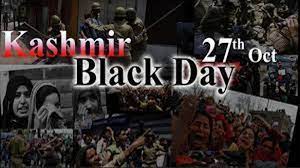Abdullah Malik
In the annals of Kashmir’s turbulent history, October 27, 1947, stands as a somber and fateful day. It marks the moment when India deployed its troops to seize control of Kashmir, sparking a chain of events with deep and enduring consequences. This delves into the historical context, the ongoing struggle for freedom in Occupied Kashmir, the evolving landscape, and the intricate international dynamics that envelop this protracted conflict.
The roots of the Kashmir conflict stretch back to the period leading up to India’s independence in August 1947. During this pivotal time, the Maharaja of Kashmir entered into an agreement with the Government of Pakistan, pledging that the same arrangements existing under British rule would continue with Pakistan. Regrettably, these promises were broken, setting the stage for enduring disputes. The pursuit of Kashmiri freedom has endured for over seven decades.
Despite facing decades of Indian oppression, the resilient people of Kashmir have never relinquished their aspiration for self-determination. However, as time has passed, the situation has grown increasingly intricate. The year 2019 marked a turning point when India unilaterally altered the constitutional status of the disputed region to fortify its illegal occupation of the valley. Following this move, India issued 5.41 lakh domicile certificates, primarily to Hindus, raising concerns about demographic shifts in the region.
The human rights situation in Kashmir remains dire. The presence of 900,000 Indian soldiers in the region since 1991 has led to widespread violence and repression. Recent estimates reveal a stark reality: 96,000 Kashmiris have fallen victim to extrajudicial killings, 162,000 individuals have been unlawfully detained, over 25,000 have been wounded by pellet guns, and thousands of women have been widowed, leaving children orphaned. The Indian government’s strategy includes stifling information and communication. Since 2017, major social media platforms have banned content related to the Kashmiri freedom movement.
India is a global leader in internet shutdowns, leading to significant hardships for the local population. The Kashmir conflict often receives limited international attention due to several factors. Geopolitical tensions between major powers, especially the United States and China, play a pivotal role. The U.S. views India as a crucial ally in countering China’s ascent, resulting in diplomatic and political support for India. In the complex landscape of international relations, interests often take precedence. The Western world regards India as both an economic market and a strategic partner in countering China’s growing influence.
This selective approach shapes responses to issues involving India, even when they pertain to human rights In conclusion, the quest for Kashmiri freedom is a protracted narrative marked by hardships, sacrifices, and unwavering resolve. While October 27, 1947, stands as a dark and enduring day in Kashmiri history, the hope for a brighter future endures.
This hope is nurtured by the unyielding determination of the Kashmiri people in their ongoing struggle for self-determination and peace. As the world grapples with shifting power dynamics, the fate of Kashmir continues to hang in the balance, transcending borders and resonating with all who champion justice and human rights. The enduring struggle for Kashmiri freedom serves as a stark reminder of the enduring yearning for self-determination and justice in an ever-evolving global landscape.







